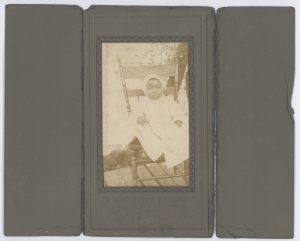The photograph [Ten-month-old portrait of Gladis May Kell(e?)y] features a depiction of a black infant wearing a dress and close-fitting bonnet seated in an outdoor setting.[1] This object has an inscription written on its mount below the image. The mount is grey in color and the inscription was written in pencil, rendering it more an indentation from the pressure of the hand composing the text than writing and therefore difficult to make out. Mostly decipherable, however, the autograph reads: “Gladis May Kell(e?)y/ Born Jan. 7th 192(2?)/ aged ten months/ when picture taken.” I cataloged this object for the class Curating Hidden Collections and the Black Archive and purposefully filled the title, description of the piece, and transcription of the writing with question marks and parentheses. My trepidation about an accurate reading of the inscription is readily apparent through these clusters of punctuation.

[Ten-month-old Portrait of Gladis May Kell(e?)y], The Baltimore Collection, Accession number 2001.0017.0025, University of Delaware Library, Museums, and Press.
When I first chose this object to work on I had confidence that I would be able to learn a great deal about the sitter due to this handwritten identification. I began my research using the object’s digital surrogate. Upon opening the high-resolution image on my computer my confidence waned as I realized that no amount of zooming would render the inscription completely legible. I maintained my optimism, however, with the knowledge that soon I would be able to view the object in person. Even after examining the photograph and its mount with a magnifying glass and spotlight I still could not make out the writing with any degree of certainty. I resigned myself to the clunky title, setting aside aesthetics for the sake of honesty.
Aesthetics, however, were not the only thing at stake in this decision to be ambiguous. When conducting research on this photograph, I had only the image’s visuality and the inscription as a starting point. Unlike other objects in “The Baltimore Collection,” there is no photographer or photographic studio listed on the item; the only information, apart from the image, is the writing. I perceived that my ability to uncover the identity of the sitter hinged on my ability to read the inscription. This emphasis on written over visual language laid bare shortcomings in my own training. For instance, a photograph conservator would have no issues creating a coherent history for this object based on the photograph itself, inscription or no inscription. Despite this realization, I kept pushing to understand the handwriting and that aspect of the object alone.
I was able to track down a Gladis Kelley in the 1920 Pennsylvania census. This Gladis Kelley was listed as 1-month-old at the time of the census and residing in North Fayette, Allegheny, PA. Her parents are Charles D. and Norene Kelley and her sister is Georgetta. More convincingly, this family is identified as black. Everything seemed to be falling into place: the location fit into the geographic areas associated with “The Baltimore Collection” and the child depicted in the photograph is black. At the time of finding this entry, however, I had decided that the date on the photograph was 1922, a fact that would not line up with this appealing census entry. I looked back at the photograph: Was I simply reading the inscription incorrectly? Was I sure that ending number was a 2?
I was now influenced by the information I had found and it was swaying my reading of the object. I stared longingly at the inscription, willing it to read what I wanted it to read. In my quest to fit the pieces together, I began to think what it would mean for me to identify this sitter incorrectly. Would it not undo the work we were undertaking in this class, to return agency to the individuals in the photographs, recognizing the historical deficiencies of archival knowledge in recording black life? The allure of the inscription and its ability to make sense of the object had overcome me. I found myself in a power struggle with the photograph due to my incessant need to identify it.
Of course, this inscription was not written for me, a stranger to this child’s family. Someone involved in the child’s life, someone whose handwriting would have been instantly recognizable due to its familiarity, most likely wrote these words that I was struggling to make out. There is an intimacy inherent to this object that resists my attempts to identify it neatly. The photograph actively combats the rationality of the cataloging process and the power structure associated with it. It retains its mystery and asserts a powerful agency through this resistance. At the same time, however, the object does not repel me as a viewer (or a researcher). It invites me in, its stories just outside my reach, to sit with it as equal partners in the creation of its meaning.
[1] The title of this photograph appears in brackets to indicate that it was devised by the cataloger and not formally given to the title at the time of its creation.

